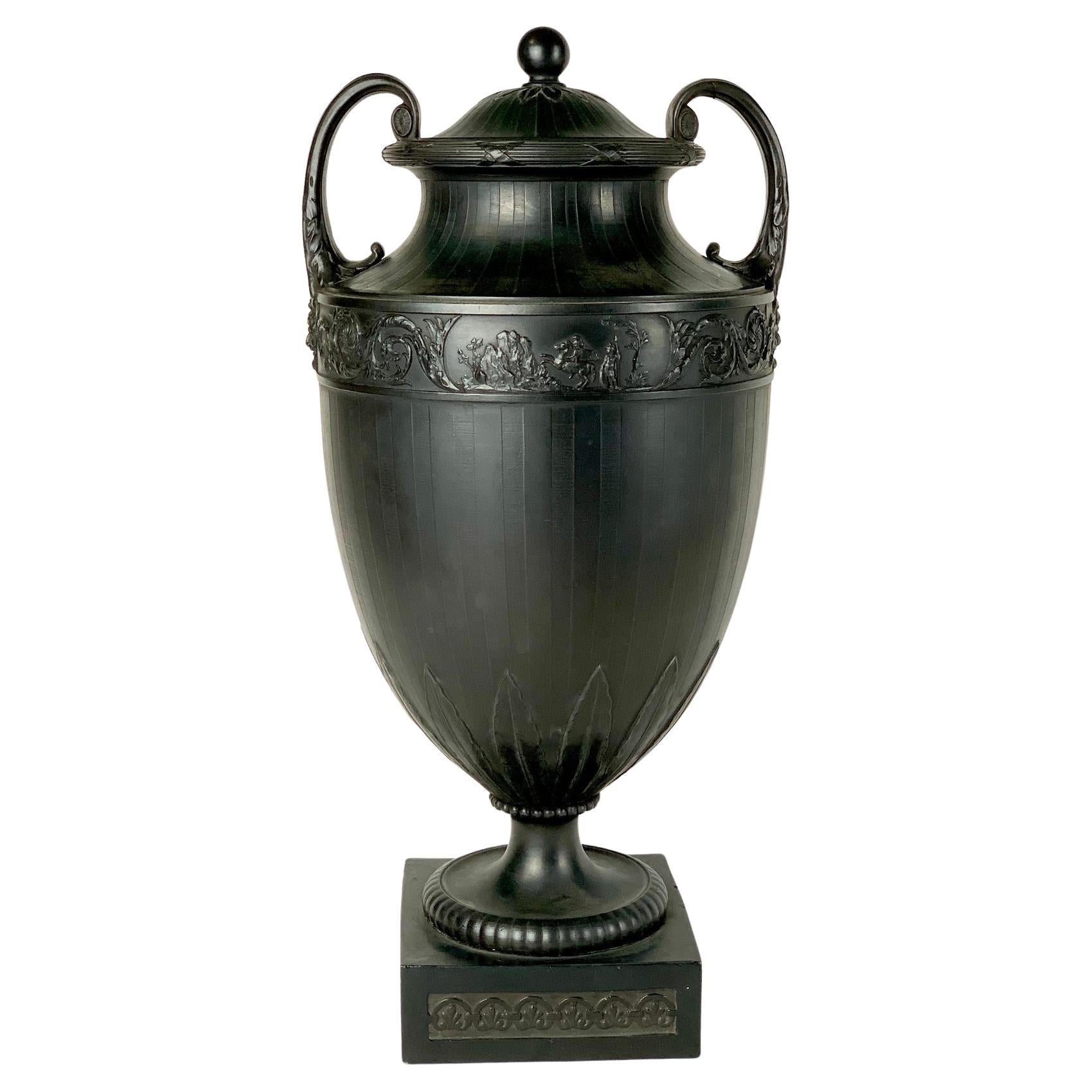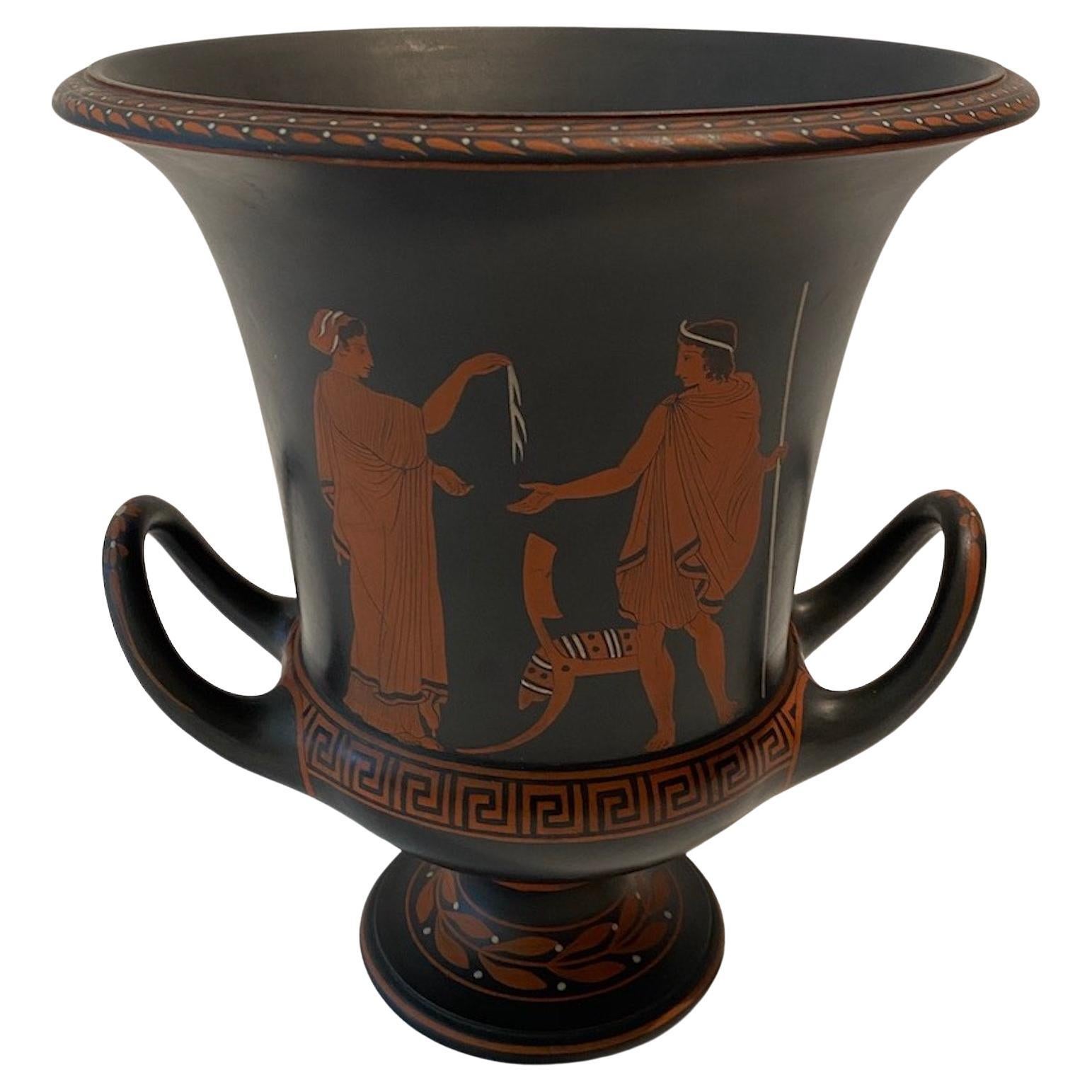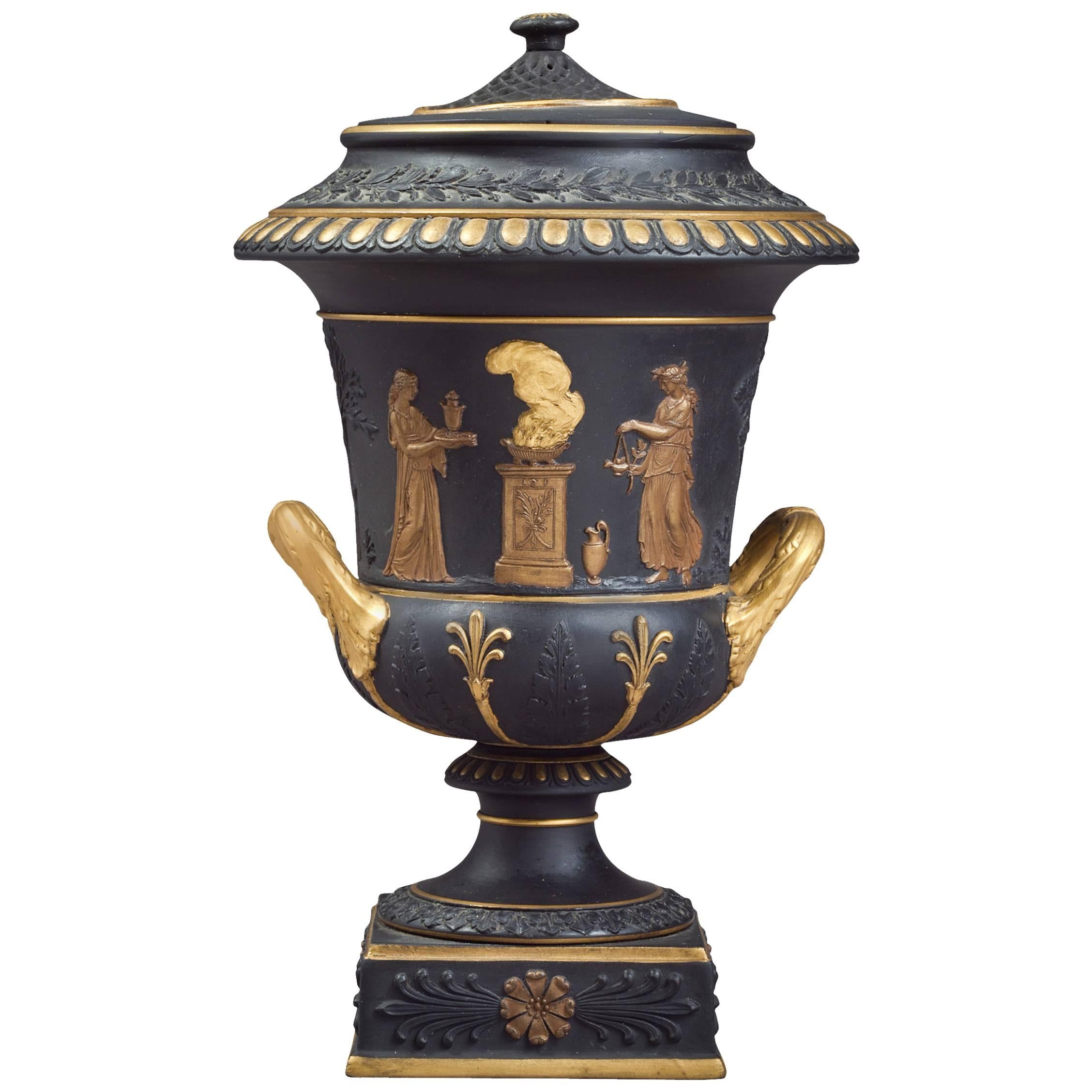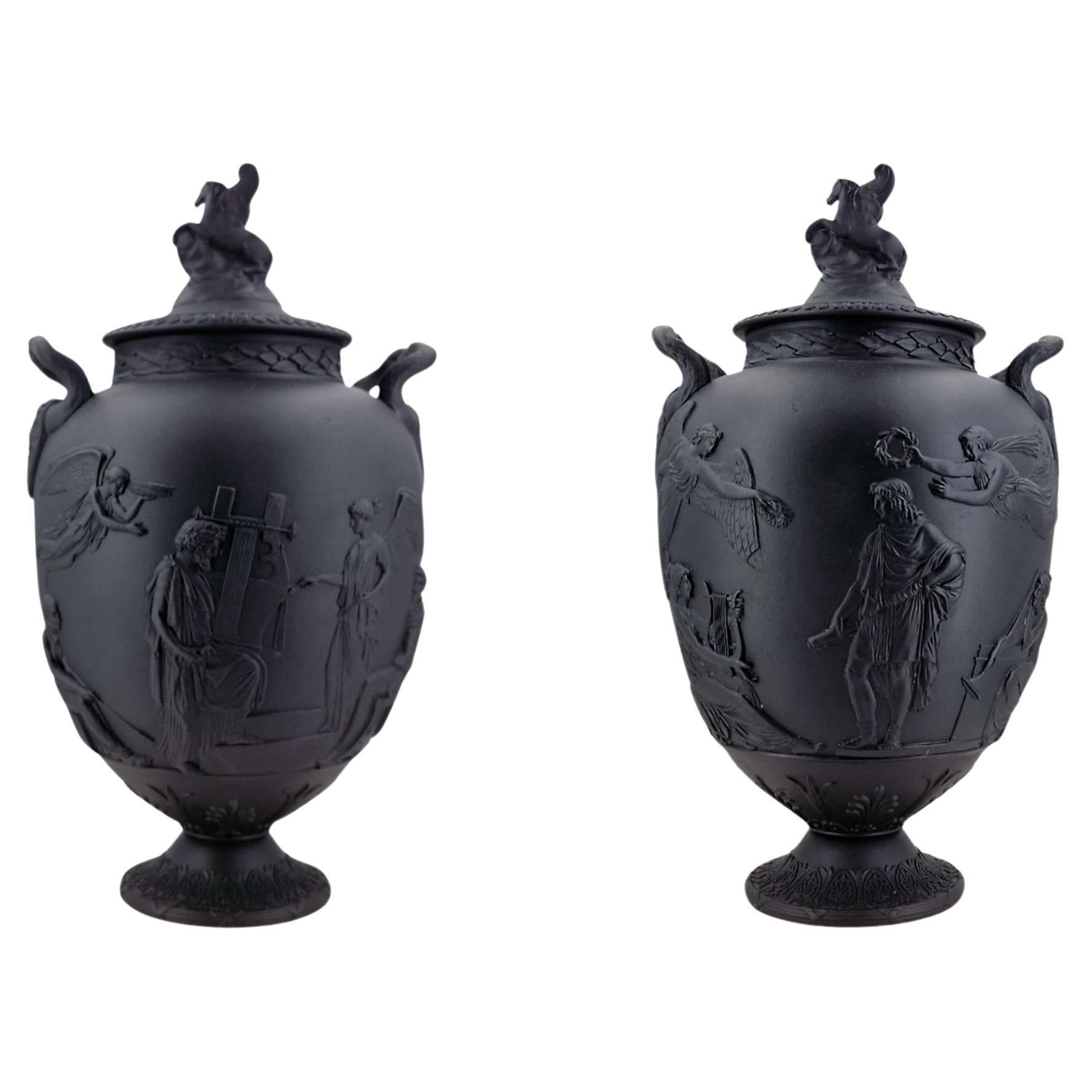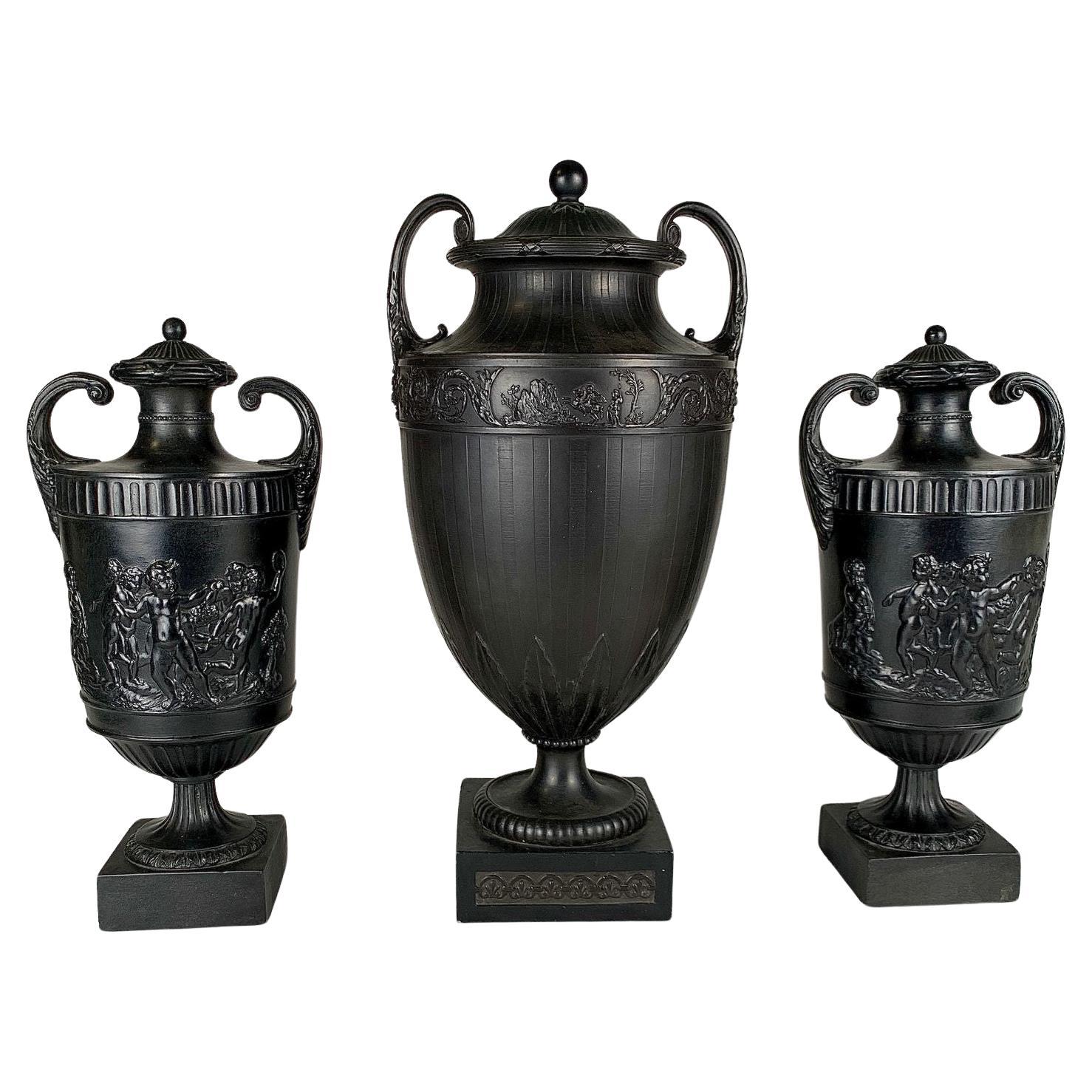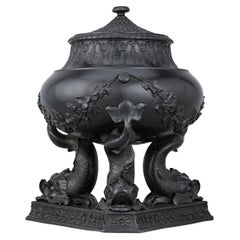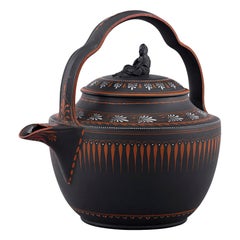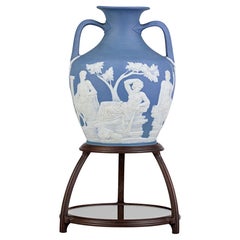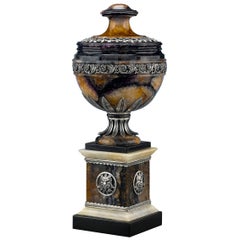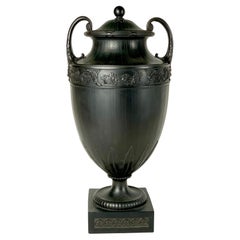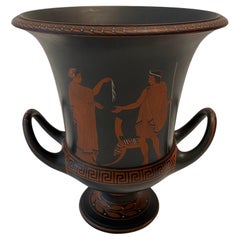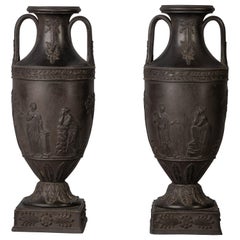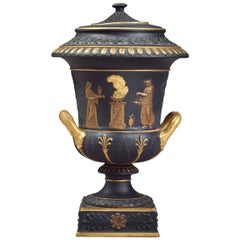Items Similar to Wedgwood Black Basalt Two-Handled Urn
Want more images or videos?
Request additional images or videos from the seller
1 of 8
Wedgwood Black Basalt Two-Handled Urn
$19,850
£15,171.32
€17,486.16
CA$28,429.02
A$31,157.34
CHF 16,270.95
MX$373,852.11
NOK 204,309.62
SEK 192,452.09
DKK 130,576.95
About the Item
A remarkable example of Josiah Wedgwood's legendary ceramic art, the importance and rarity of this urn vase simply cannot be overstated. Black basalt refers to the fine-grained stoneware developed by Josiah Wedgwood in the 1760s that was inspired by the hard, natural stone known as Egyptian basalt. Wedgwood achieved the rich, lustrous dark color by combining manganese and an iron-rich oxide slurry called carr. This provided additional strength and solidity but also made it more challenging to work with. Today, the wares crafted of this beautiful material are highly desirable and sought by collectors. The sleek and graceful design is a testament to Wedgwood's artistry and skill as a potter and ceramicist.
Bearing a two-handled shape recalling Classical pottery, Neoclassical scenes of maidens outfitted in togas alongside swags of flowers and stiff leaves applied in ornamental relief decorate this refined vase.
19th century
Impressed uppercase mark
22" high x 11 1/4" wide x 11 1/4" deep.
- Dimensions:Height: 22 in (55.88 cm)Width: 11.25 in (28.58 cm)Depth: 11.25 in (28.58 cm)
- Materials and Techniques:
- Place of Origin:
- Period:
- Date of Manufacture:19th Century
- Condition:
- Seller Location:New Orleans, LA
- Reference Number:Seller: 31-42481stDibs: LU891130151922
About the Seller
5.0
Recognized Seller
These prestigious sellers are industry leaders and represent the highest echelon for item quality and design.
Established in 1912
1stDibs seller since 2010
112 sales on 1stDibs
Typical response time: 8 hours
- ShippingRetrieving quote...Shipping from: New Orleans, LA
- Return Policy
Authenticity Guarantee
In the unlikely event there’s an issue with an item’s authenticity, contact us within 1 year for a full refund. DetailsMoney-Back Guarantee
If your item is not as described, is damaged in transit, or does not arrive, contact us within 7 days for a full refund. Details24-Hour Cancellation
You have a 24-hour grace period in which to reconsider your purchase, with no questions asked.Vetted Professional Sellers
Our world-class sellers must adhere to strict standards for service and quality, maintaining the integrity of our listings.Price-Match Guarantee
If you find that a seller listed the same item for a lower price elsewhere, we’ll match it.Trusted Global Delivery
Our best-in-class carrier network provides specialized shipping options worldwide, including custom delivery.More From This Seller
View AllWedgwood Black Basalt Pastille Burner
By Wedgewood
Located in New Orleans, LA
Wedgwood began crafting pastille burners in the early nineteenth century, and this stunning dolphin burner is a gorgeous example of his innovative desi...
Category
Antique 19th Century English Decorative Bowls
Materials
Ceramic
Wedgwood Black Basalt and Encaustic Enamel Rum Kettle
By Wedgwood
Located in New Orleans, LA
Crafted by Wedgwood, this rare, round-shaped rum kettle is comprised of black basalt and features a molded bail handle and glazed interior. Referred to as “...
Category
Antique Early 19th Century English Classical Greek Ceramics
Materials
Enamel
Wedgwood First Edition Portland Vase
By Josiah Wedgwood
Located in New Orleans, LA
This extraordinary First Edition Wedgwood rendering of the legendary Portland Vase is one of the rarest masterpieces of Josiah Wedgwood, the most important ceramics manufacturer of the 18th century. A tour de force of ceramic art, the Portland Vase First Editions are regarded as one of the greatest ceramic accomplishments of the 18th century, and they are a testament to the superior skill of Josiah Wedgwood, his extraordinary ambition and his tireless dedication to perfection. One of the very few First Editions still in private hands, this exceptional Wedgwood Portland Vase is one of the most important works of ceramics on the market.
The story of Wedgwood and the Portland Vase is legendary. The original Portland Vase is the ancient world's most famous decorative arts masterpiece—a cameo glass vase dating to circa 25 CE with a frieze representing the myth of Peleus and Thetis, initially thought to be carved from stone. When it was first rediscovered around 1582, it captivated the world with its opaque white cameo figures over its rich blue background. After the vase was excavated it was owned by Cardinal Barberini, whose family later sold it to the Duke of Hamilton who eventually sold it to the Duchess of Portland, from whom the famed vase now takes its name.
The famed British sculptor John Flaxman was likely the first to have brought the vase to Wedgwood’s attention. In a letter dated February 5, 1784, he wrote: “I wish you may soon come to town to see William Hamilton’s vase, it is the finest production of Art that has been brought to England and seems to be the very apex of perfection to which you are endeavouring to bring your bisque and jasper…” Indeed, the Portland Vase is a masterpiece of cameo-cutting, with a stunning frieze of opaque white cameo glass over its translucent deep blue form. Its beauty and translucence would inspire Wedgwood to undertake his years-long endeavor to precisely replicate the original in porcelain.
Upon closer examination, Wedgwood realized the vase was not made of stone or earthenware, but of cameo glass—a technique so advanced it remains the masterpiece of cameo-cutting. Today, the vase is housed in the British Museum, where it is the second most viewed antiquity, only after the Rosetta Stone. It then took Wedgwood several painstaking years to craft his unparalleled copy of the vase, during which he perfected the jasperware technique that would become his crowning achievement. To this day, the renowned porcelain firm regards the vase as its most momentous triumph, so much so that the vessel’s silhouette is incorporated into the Wedgwood logo.
The four years it took Wedgwood to complete his vase were not without tribulations. From the start, Wedgwood encountered numerous problems with his copies, from cracking and blistering to the difficulty of replicating the translucent effects of the original. The first acceptable copy was produced in October 1789 and sent to Wedgwood’s physician and friend Erasmus Darwin, the grandfather of Charles Darwin. Wedgwood presented another copy to Queen Charlotte in May 1790 and afterward organized a private exhibition of the vase at the Portland House in London. The viewing proved so popular that Wedgwood was forced to restrict the show to 1,900 visitors. Much of London wished to see Wedgwood’s greatest major achievement. Perhaps the highest praise of Wedgwood’s copy came from the famed artist Sir Joshua Reynolds, the founder of the British Royal Academy: “I can venture to declare it a correct and faithful imitation, both in regard to the general effect, and the most minute detail of the part.”
Over the next few years, Wedgwood's oven records listed 43 First Edition copies of the Portland Vase produced between 1791 and 1796, 11 of which were broken during the firing process. In all, it is believed around 30 First Edition vases were completed, though an unknown number of these were somewhat damaged—one of these imperfect examples is currently held by the Victoria & Albert Museum in London. The perfect examples such as ours have found their way into the most important museum collections in the world. The British Museum (London), Art Institute of Chicago, Birmingham Museum of Art, Museum of Fine Arts (Boston) and the Fitzwilliam Museum (Cambridge, UK), among others, all hold one of these highly coveted vases in their collections.
In terms of technical achievement, the First Edition Portland Vases...
Category
Antique 18th Century English Classical Roman Vases
Materials
Porcelain
Georgian Blue John and Silver Urn
By Sir William Chambers
Located in New Orleans, LA
This important George III blue John urn is attributed to famed Swedish architect Sir William Chambers. The solid piece is carved entirely from rare Blue...
Category
Antique 18th Century English Neoclassical Urns
Materials
Stone, Marble
Wedgwood Tri-Colored Jasper Vase
By Wedgwood
Located in New Orleans, LA
This exceptional and rare Wedgwood tri-colored jasper vase exemplifies that renowned firm’s classical artistry. Crafted of jasper, perhaps the greatest of Josiah Wedgwood’s porcelain innovations, in the shape of an ancient Greek calyx krater...
Category
Early 20th Century English Classical Greek Vases
Materials
Ceramic
Thomas Webb & Son Two-Handled Cameo Amphora Vase by Thomas Woodall
By Thomas Webb & Sons
Located in New Orleans, LA
Of all the glassworks produced in the late 19th century, cameo glass was the most challenging to perfect. Only a handful of artisans succeeded in mastering this intricate craft, with...
Category
Antique Late 19th Century English Vases
Materials
Glass
You May Also Like
18th Century Large Wedgwood & Bentley Black Basalt Jar England Circa 1775
By Wedgwood & Bentley
Located in Katonah, NY
This impressive black basalt jar, crafted by Wedgwood and Bentley at the renowned Etruria factory, embodies the refined simplicity of the neoclassical style.
The jar features an elon...
Category
Antique Late 18th Century English Neoclassical Jars
Materials
Stoneware
Wedgewood Black Basalt Stone Urn
By Wedgewood
Located in Los Angeles, CA
Wedgewood encaustic painted , matte finished black basalt stone urn. Hand painted decoration with 2 scenes. Egyptian Revival style. Circa 1790-1820.
Category
Antique 1790s English Egyptian Revival Urns
Materials
Stone
Pair of Wedgwood Black Basalt Two-Handled Vases, circa 1900
Located in New York, NY
Decorated with a frieze of classical figures between a berried vine border and upright acanthus leaves. The neck similarly decorated with pendant trophies between upright handles.
Category
Antique Early 1900s British Vases
Materials
Ceramic
Wedgwood Black and Gilt Basalt Covered Potpourri Vase, circa 1870
Located in New York, NY
A wedgwood black and gilt basalt covered Potpourri vase, circa 1870.
Category
Antique 1870s English Neoclassical Vases
Materials
Ceramic
Pair of Apotheosis Vases in black basalt, Wedgwood, circa 1880
By Wedgwood
Located in Melbourne, Victoria
A stunning pair of vases in black basalt. Known as Apotheosis Vases, or sometimes Pegasus Vases, it's rare to find a pair of these; still rare to find the...
Category
Antique Late 19th Century English Neoclassical Vases
Materials
Stoneware
A Set of Three Wedgwood Black Basalt Vases, England, Circa 1775
By Josiah Wedgwood
Located in Katonah, NY
Here is a magnificent ensemble of three Wedgwood vases that seems to embody the entire spirit of 18th-century English neoclassicism: its balance, its discipline, and its love of the ...
Category
Antique 1770s English Neoclassical Jars
Materials
Stoneware
More Ways To Browse
Antique Wedgwood
Wedgwood England
Black Wedgwood
Antique Black Wedgwood
Two Handled Vessel
Wedgwood England Vase
Wedgwood Basalt
Wedgwood Black Basalt
Antique Wedgwood Basalt
Wedgwood Black Vase
Basalt Vase
Black Basalt Vase
Two Handled Vases England
Ceramic Urn Handles
Wedgwood Black Basalt Vase
Wedgwood England Urn
Basalt Urns
Black Basalt Urn
